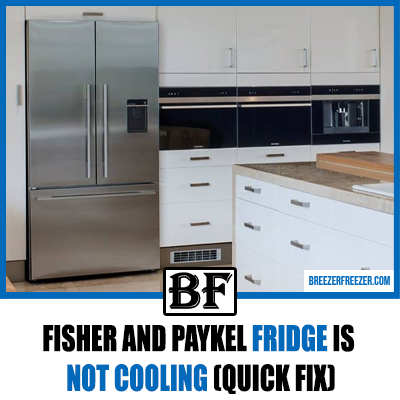Samsung Ice Maker Keeps Freezing Up
Wondering why the new ice maker in your Samsung refrigerator keeps freezing?

This issue usually requires more than just adjusting the temperature. And unless you fix the underlying problem, using new ice makers frequently won’t bring any solution.
So, we thought it would be a good idea to help our readers understand why their ice maker keeps freezing and how to deal with it. Moreover, most of our suggestions work for different models of Samsung fridges, so you can implement them immediately.
With all said and done, let’s dive in now!
What To Do If The Samsung Refrigerator Ice Maker Is Freezing Up?
1. Check The Temperature
One of the first and most basic things you can do if your Samsung ice maker keeps freezing up is checking the temperature. It’s a no-brainer that extremely low temperatures can cause different parts of the refrigerator to freeze. So, turn up the temperature if it’s set at lower than 0 degrees Fahrenheit.
Aside from that, you will need to reduce the temperature if it’s above the 10-degree Fahrenheit mark. This is because if the refrigerator becomes too hot, it can make the fans and compressor work more than required to cool down the unit. And this may cause the fridge to become too cold, thereby freezing the freezer and the ice maker.
Likewise, placing the refrigerator in an area that becomes too hot (especially under direct sunlight) can invite the same problem. So, make sure you place it at the right corner from the get-go; trust us- dragging it through rooms to find the right place is no fun!
But if you can’t reposition it for some reason, then ensure that that temperature is set at the lowest recommended point. This will help optimize both the cooling and ice production process without the added risk of freezing any part.
2. Inspect The Compartment
If the temperature isn’t the problem, then you can move on to checking the ice compartment for potential leakages. Simply hold a flashlight below the compartment and see if the light reflects inside. If yes, then there are possible cracks that need to be sealed.
A leak can allow humid air to enter the compartment and form frost deposits around the ice maker, keeping it from making ice.
Start by removing both the ice maker and the ice bucket, after which you can take out the auger motor assembly. Then, use an epoxy sealant to seal the areas (along the back and left side) from where the light was reflecting. Most epoxy sealants take at least 24 hours to dry out completely but make sure to refer to the manufacturer’s instructions to figure out the exact drying time.
Once the said period is over, reinstall the auger, ice maker, and bucket and reset the ice maker.
3. Examine The Ice Bucket Gasket
A faulty ice bucket gasket will invariably affect the temperature around the ice maker, as it may facilitate the entry of warm air into the compartment. This, in turn, can cause an unnecessary buildup of ice, which is why the ice maker freezes up.
In case the gasket appears loose or damaged, replace it immediately with a new one.
4. Fix The Ice Chute Flap
For the unversed, the ice chute flap in Samsung refrigerators is essentially a door that helps keep the chute covered. Ideally, it should always rest flushed on its frame, which prevents warm air from coming in contact with the ice maker. Otherwise, it will freeze up over time.
But sometimes, a block of ice (or an ice cube, for that matter) can prevent it from closing properly. In such a situation, you can easily remove it to make the flap stay shut.
However, if you cannot see any ice blocking the door, it may be a good idea to pour warm water (not boiling) on the chute. This is an effective way to break any “invisible” ice deposits on or around the top of the chute. Wait for some time after pouring the water, clean up any excess water, and see if the flap closes completely.
Samsung fridge ice flap keeps opening and closing
A Samsung fridge with an ice flap that keeps opening and closing can be caused by a malfunctioning ice flap actuator. This can happen when the actuator becomes stuck or worn out, causing the flap to open and close on its own.
To fix this issue, the actuator needs to be checked and possibly replaced. If the flap is not properly sealed, it can also cause the issue, in this case, it needs to be cleaned and adjusted.
Additionally, check if the ice maker is jammed not over producing ice, or if the bin is not full, this can cause the flap to open and close frequently. If the problem persists, it is recommended to consult the user manual or a professional service for further assistance.
5. Investigate The Water Line
A frozen water line can also be the reason why your Samsung ice maker keeps freezing. When the water line freezes, it causes low water pressure by essentially restricting the water supply to the ice maker. Hence, the ice maker keeps running while producing little or no ice at all, causing it to freeze after some time.
You can pour some hot water (again, not boiling) on the water line using a syringe or similar tool to melt any accumulated ice. However, if you’re confident about your DIY skills, then we’d strongly recommend removing the frozen water line completely. Then, use a hair dryer to slowly melt the ice and reinstall it.
Remember that excessive heat can wrap the water line since it’s made of plastic. And if it’s damaged, you will need to replace it with a new one.
6. Ensure That The Water Inlet Valve Is Functioning Properly
Most malfunctioning water inlet valves cause the ice mold to overfill, and the excess water near the ice maker, freezing eventually. So, how do you determine if the water inlet valve needs to be fixed?
As the first step, detach the valve’s screen filter and use some gentle soap and warm water to give it a thorough cleaning. After this, use a multimeter to confirm that the solenoid (or the coil) of the ice maker is receiving electric current. If not, then it’s time to replace it.
7. Check The Freezer Door
Believe it or not, a faulty freezer door is among the most common yet overlooked causes for a frozen ice maker. In case the door doesn’t close all the way through, the outside air will come in contact with the cool air inside the freezer, resulting in almost instant frost. Hence, it’s essential to check that the freezer door seal hasn’t become ineffective.
To do this, run your fingers around the door when it’s being closed. If you feel the cold air on your skin, then there’s a certain leak that needs to be taken care of.
Alternatively, you can place a thin sheet of paper between the door frame and the rim of the fridge and close the door. Then, try to pull the paper; if you see that it comes out in one swift motion (or without any significant resistance), then the seal should be replaced.
What To Do If The Freezer Is Over-Freezing?
If you have noticed that the freezer is over-freezing, different from not freezing, then there’s a good chance that it will also cause the ice maker to freeze up at some point in time. So, here are a few tips and tricks that can help you keep over-freezing at bay.
1. Take Care Of The Door
We can’t stress enough on the need for closing the freezer door all the way through every time it’s opened. Not only that, but you should also ensure that the door isn’t open for too long at a time. Long story short, you should prevent the cold air from escaping and the (relatively) warm air from replacing it inside the fridge.
Moreover, make it a point to clean the door seal regularly with a warm water and soap solution, especially if there’s a buildup of dirt and grime on it. This will keep it effective for prolonged periods, and you don’t have to fret about replacing it frequently, even with rough use.
We’d also suggest keeping the back wall free from clutters, as the items stored therein will stay close to the air vents. This will affect the overall ventilation and may result in an excess buildup of ice.
If your Samsung refrigerator has a bottom drawer, then ice deposits can prevent it from being closed properly, which will also damage the seal before time. Intense ice buildups often require manual defrosting, which can be achieved with the forced defrost mode. But if the ice deposit is not stubborn enough, you can carefully scrape it out with a knife or any other sharp tool.
2. Keep The Unit Properly Ventilated
Keeping the refrigerator properly ventilated is the key to ensuring that the temperature inside remains constant at all times. Organize the items in such a way that they don’t block the air vents or restrict the airflow. Similarly, avoid placing the fridge too close to the wall.
If the vents remain obstructed for long, then the areas near them will become colder than the others and may even freeze up. A great tip to prevent overcrowding the fridge is to make sure that it’s only ½ or 3/4th full. This makes sufficient room for the air to circulate freely and helps the items absorb all the cold air.
3. Clean The Condenser Coils Clean
The condenser coils are usually located at the bottom back of the refrigerator and should be cleaned regularly. We’d suggest using a vacuum or condenser brush to eliminate any dust, dirt, or grime from them.
When the condenser coils don’t work properly, the unit tries to make up for it by cutting down on heat distribution. This can cause the other parts (like the compressor and fans) to work more aggressively and freeze the inside.
4. Keep The Door Aligned
Uneven floorings can sometimes disrupt the alignment of the door. Or, there can be gaps if you have reinstalled the door after repair or maintenance. Hence, warm air from the outside may enter the freezer.
As a rule of thumb, always ensure that the hinges are tight and the door stays aligned with the rest of the unit. If you observe any anomaly, look up the user manual to fix it yourself or request service from professionals.
5. Clean The Defrost Drain
The defrost drain (located at the back wall of the unit) can get clogged either with ice or dust and debris that has accumulated over time. For the former, pour hot water with a measuring cup on the hole to melt the ice. Continue doing so until you see the poured water flowing out to the drain pan.
On the other hand, you can break down debris buildup inside the drain using a hardwire or hot water and vinegar solution. You know the buildup has cleared when the water flowing to the drain pan is clean.
6. Manually Defrost The Freezer
A majority of the newer models today are designed to be frost-free, so over-freezing can indicate a problem in the freezer compartment or the defrost mechanism. If it has happened for the first time, then you can try manually defrosting your Samsung refrigerator.
For an older model, you can manually defrost it by removing the items inside and switching off the power supply. At the same time, keep the door open until you see all the ice has melted. Then, wipe off the excess moisture and let the unit dry completely before switching it back on.
A pro tip: cover the nearby floor with towels or any other cloth that can absorb the melted ice water.
Samsung Fixes:
- How To Clean A Samsung Refrigerator Drawer
- Fix The Fan Noise On A Samsung Refrigerator
- Samsung Freezer Not Working (Quick Fix)
- How To Add Apps To A Samsung Refrigerator
- How To Turn Off A Samsung Refrigerator
- How To Reset The Filter Light On Your Samsung Refrigerator
- Samsung Ice Maker Noise (How To Fix)
- Samsung Ice Maker Won’t Come Out
Final Words
If everything else seems fine, then the thermistor or temperature control thermostat may have gone haywire. And you can test the current flow with the help of a multimeter. If one (or both) doesn’t conduct electricity, then they need to be replaced. Beyond that, check if the air damper control has opened, which can indicate damage.
While DIY repairs and fixes aren’t difficult per se, you should always wear adequate safety gear like rubber gloves to prevent getting electrocuted. Similarly, don’t forget to switch off the power supply to the fridge when working.
However, people who don’t have much experience working with electronic items should contact the professionals without any delay.




![Brand New Fridge Making Noise? [17 Causes & Fixes!]](https://breezerfreezer.com/wp-content/uploads/2023/10/Brand-New-Fridge-Making-Noise.png)